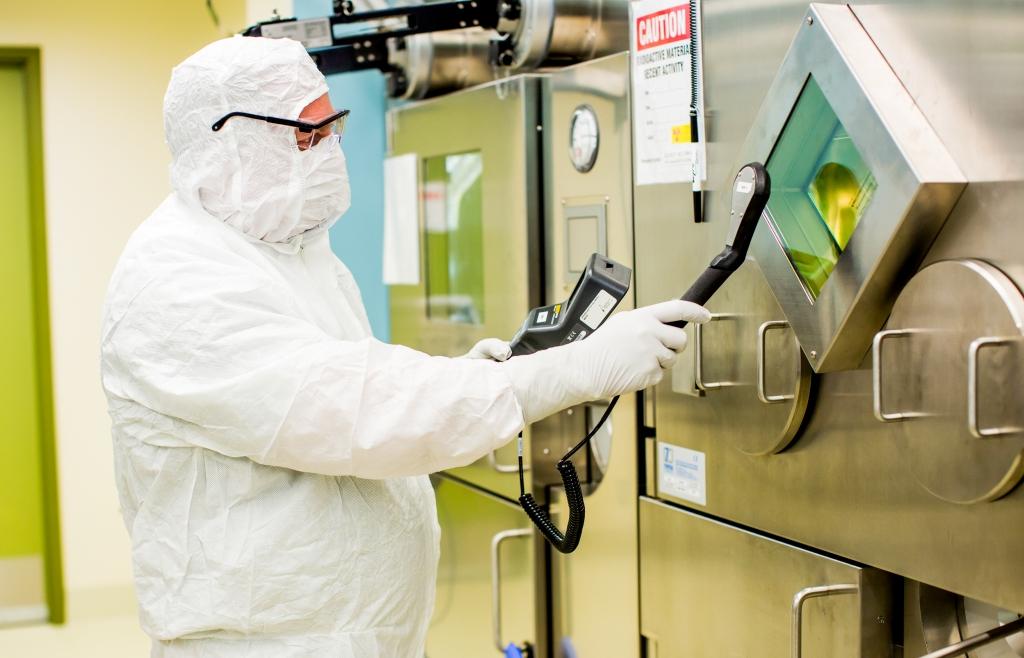Finding Innovative Ways to Use Radioactive Isotopes to Solve Common Problems
August 15th, 2019 by Dr. Michael Campbell
Vision for research
The goal of my research program is to find new and innovative ways to use radioactive isotopes to solve common problems. My research lab applies chemistry techniques used for the synthesis of drugs, polymers or other common materials to find ways of working with these radioactive materials to answer specific questions.
Some of the questions we are looking at include:
- Is there a better way to attach this radioactive atom to a radiopharmaceutical?
- What precious metals are in this ore sample?
- Are there better ways to produce and distribute medical isotopes?
First, a bit about what radioisotopes are. Most of us will remember seeing the little cartoons of an atom where you have the electrons around the outside and the nucleus in the middle. If we zoom in to the nucleus you will find positively charged particles called protons. The number of protons is what determines if the atom is hydrogen, carbon or some other element. We will also see particle that don’t have any charge called neutron. In most atoms if the number of protons and neutrons are balanced within a certain range the atom is stable and most likely has been around for billions of years and most likely will be around for another billion or so. Where it gets interesting is when the number of neutrons gets out of balance, this makes the nucleus unstable and is radioactive. To get to a stable state the atom releases some energy, this energy is what we detect when we use radioisotopes to diagnose or treat diseases.
Where do the radioisotopes come from?
There are many sources of radioisotopes. Many radioisotopes are naturally occurring, if you pick up a piece of granite chances are there are at least some radioactive atoms present. Radioisotopes can also be created. In Thunder Bay, we are fortunate to have a cyclotron that can give us access to a variety of isotopes and facilities for working with these materials.
How do you use radioisotopes help detect diseases and what are the challenges?
The main isotope that the cyclotron produces for the detection of cancer is a radioactive version of fluoride called F-18. If only F-18 was given to a patient it wouldn’t have any way of guiding it to the tumour, it needs to be attached to a drug that is able to seek out the tumour. This is where we come in. Chemists have developed many processes for connecting atoms to molecules but with Radiolabeling compounds one of the big (or very small in this case) problems is one of scale. A very small amount of radioactive material goes a long way. If we use the example of F-18 from our cyclotron as an example, the amount of F-18 that is in an actual dose is less than 1 nano gram. To put that in perspective if you take a single grain of salt, that is 10,000 times larger than the amount of F-18 in a single dose used to detect cancer.
When working on this scale it is impossible to weigh out materials at that small a scale and as a result, the amount of other reagents the F-18 has to react with are in huge excess. What this means is that after the reaction is done, there is a lot of other stuff that needs to be removed in order to get a pure product. This is where the next problem comes up, the material is radioactive after all so that means that the normal methods of handling and purifying compounds become more difficult and can’t be handled directly. The final challenge is time, as F-18 only has a half life of 110 minutes. That means approximately every 2 hours you have half as much material remaining so we need to work fast.
The work we are doing hopes to address these problems. We are taking the molecules that the F-18 reacts with and attaching them to a tether and then attaching the other end of the tether to a small plastic bead. We have set up the attachment of the molecule to the tether in such a way that when it reacts with F-18 the tether is cut and the radioactive molecule is now in solution. What this lets us do is to remove any excess molecules by sampling filtering off the plastic beads. This may not work for every molecule but it will hopefully allow us to prepare and purify molecules that we otherwise difficult to make.
Funding
The research in my lab would not be possible with out the generous support of the following group:
Thunder Bay Regional Health Research Institute
The National Science and Engineering Research Council
Acsion Industries in Pinawa, Manitoba
